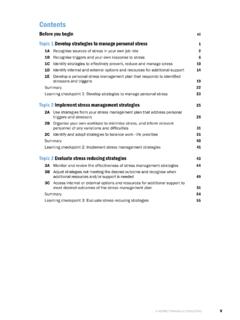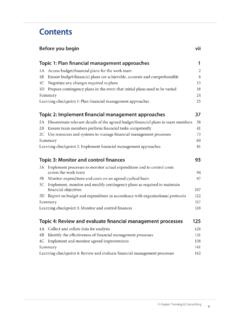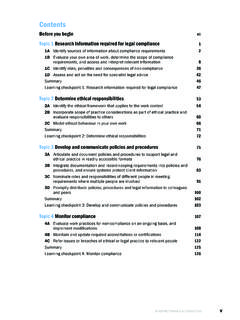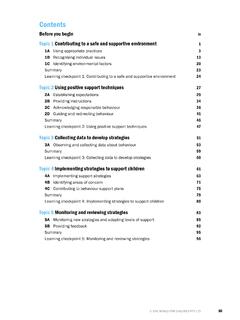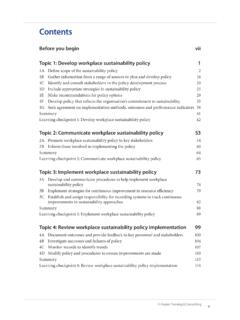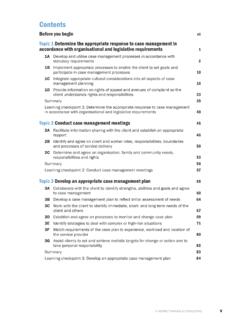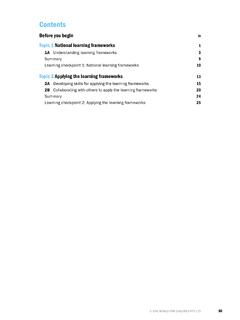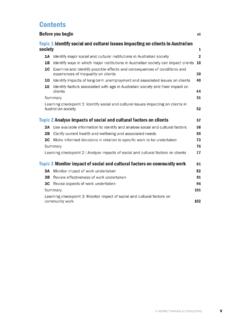Transcription of HLTWHS004 Manage work health and safety
1 ASPIRE TRAINING & CONSULTING vContentsBefore you begin viiTopic 1 Establish work health and safety practices 11A Access and interpret WHS legislation, regulations, code of conduct and workplace policies and procedures 21B Develop procedures for hazard identification, assessment and risk control 121C Monitor risk controls and hazard-specific procedures to support legislative and regulatory compliance 201D Identify requirements for expert WHS advice, and request as required 23 Summary 25 Learning checkpoint 1: Establish work health and safety practices 26 Topic 2 Facilitate consultation, cooperation and communication 332A Develop and provide activities to provide WHS advice 342B Monitor processes for ensuring that workers can contribute feedback on WHS issues 372C Document outcomes of consultation and communicate to workers 412D Develop and implement processes to ensure documentation of responsibilities, duties and accountabilities 452E Implement and monitor training programs to ensure WHS training requirements are addressed 47 Summary 52 Learning checkpoint 2.
2 Facilitate consultation, cooperation and communication 53 Topic 3 Monitor compliance with risk control processes 593A Develop WHS record-keeping policies and procedures and provide information to workers 603B Monitor hazard, incident and injury reporting processes to meet legislative requirements 643C Evaluate WHS record-keeping policies and procedures for compliance with legislative requirements 68 Summary 72 Learning checkpoint 3: Monitor compliance with risk control processes 732 ASPIRE TRAINING & CONSULTINGHLTWHS004 Manage work health AND SAFETY1A Access and interpret WHSlegislation, regulations, code of conduct and workplace policies and procedures work health and safety (WHS) legislation is one of the most important pieces of legislation dealing with the work environment in Australia.
3 It addresses the fundamental right all workers have to a safe and healthy work of the most significant changes has been the national workplace health and safety reforms that resulted in development of the work health and safety Act 2011 (Cth) and model regulations and codes of practice. These reforms are designed to improve national workplace health and safety by simplifying the system and making laws more consistent across state and territory has a regulatory body responsible for enabling and enforcing compliance with the WHS regulation. You should regularly visit your regulator s website to locate to the most up-to-date version of the Act, Regulation, Code of Practice and Industry Guideline. WHS legislationOn 1 January 2012, the work health and safety Act 2011 (Cth) came into effect, replacing the Occupational health and safety Act 1991 (Cth).
4 The WHS legislation is made up of the model WHS Act, Regulations, Codes of Practice and a national compliance and enforcement policy. This model legislation was developed by the Commonwealth government to harmonise work health and safety laws across Australia. For the Act to be legally binding, it must be passed by the Parliament in each state and territory. At this time, not all Australian states and territories have implemented harmonised WHS laws based on this new purpose of harmonising the work health and safety laws is to:XXprotect the health and safety of workersXXimprove safety outcomes in the workplacesXXreduce compliance costs for businessXXimprove efficiency for regulatory Manage work health AND SAFETYHere are examples of model codes of practice developed by Safe work model codes of practiceXXWork health and safety Consultation, Cooperation and CoordinationXXFirst Aid in the WorkplaceXXHazardous Manual TasksGeneral duty requirementsGeneral duty requirements apply to everyone working in community services.
5 General duty refers to duties that the WHS Act places upon people to ensure their own safety at work , the safety of others at the workplace and the safety of anyone else who might be injured as a result of that work . These duties are assigned to those who are in a position to control the origin of the risk and must be carried out with due diligence, otherwise known as reasonable care. The aim of these general duties is to prevent any death, injury or illness that may result from activities at that duties can be shared but never transferred, such as the duty requirement for raising WHS issues. Your community workplace should have a process for raising issues such as identified hazards, incidents and injuries to management.
6 It is the duty of all workers to report these issues either directly to management or through a health and safety representative (HSR) where appropriate. The reporting line usually follows the governance line of the workplace and an issue will be raised up through the line management; for example, through the worker, HSR, the manager and the PCbU. Here are some general duties that you can do to keep the workplace dutiesXXUnderstand and comply with relevant work health and safety reasonable care to protect your own health and safety and that of the people around the safety equipment provided by your workplace policies, procedures and any safety instructions. XXParticipate in risk management processes and report workplace hazards and and consult with people regarding risk of conductA code of conduct is a set of principles, standards, values or rules of behaviour that guide the decisions, procedures and systems of work for a workplace.
7 The code of conduct should promote the wel fare of people by protecting their rights and ensuring ethical practices are followed. The code of conduct may vary between community services workplaces; however, most community services have a code of conduct that promotes ethical behaviour, accountability, transparent sharing of information, bestowing dignity and respect and practising confidentiality. ASPIRE TRAINING & CONSULTING8 HLTWHS004 Manage work health AND SAFETYR ights and responsibilities of PCBUsThe WHS Act states that a PCbU must, so far as is reasonably practicable, ensure the health and safety of workers engaged, or caused to be engaged, by the PCbU; workers whose activities are influenced or directed by the PCbU; and other persons who could be put at risk from work carried out by or for the PCbU has overarching obligations regarding consultation, issue resolution, incident notification and compliance with regulations.
8 Responsibilities of the PCbU include, but are not limited to, the provision of:XXa safe work environment and safe systems of workXXworkplace monitoring XXsafe plant and structuresXXsafe use, handling and storage of plant, structures and substancesXXprovision of facilities for the workers welfareXXinformation, training, instruction and of careDuty of care describes the legal obligation that individuals and organisations have to anticipate and act on possible causes of injury and illness that may exist in their work environment, or as a result of their actions. A person or organisation must do everything they can to remove or minimise the possible cause of harm. While aspects of WHS legislation may vary between states and territories, there are common legislative requirements and obligations under the duty-of-care principle.
9 Everyone in the community services environment has the responsibility of duty of care for themselves, the people they care for, visitors and each diligenceDue diligence in its simplest form means to take care. This means that when you are working in the community that you take every reasonable precaution, in any given circumstance, to protect the health , safety and welfare of yourself and the people you work with. Due diligence requires that all workers understand and carry out their legal duties, assess the risk and hazards in the workplace on an ongoing basis, and take all reasonable precautions with respect to those risks. Circumstances in the community are always changing. Therefore, to ensure you practise due diligence, you need to constantly evaluate the circumstances surrounding you and ensure you are taking reasonable precautions to minimise all possible risks.
10 ASPIRE TRAINING & CONSULTING10 ASPIRE TRAINING & CONSULTINGHLTWHS004 Manage work health AND SAFETYW orkplace policies and proceduresThe type and number of policies, procedures and processes will vary depending on the nature of the work and the hazards in the specific community services environment in which you are WHS policy is a written statement of how your workplace is committed to achieving a safe and healthy workplace. These policies should be developed in consultation with workers and clearly outline the roles and responsibilities of management and workers to achieve compliance with WHS legislation. The community services procedures are documents that give specific instructions on how the requirements of the WHS policies are to be met.
